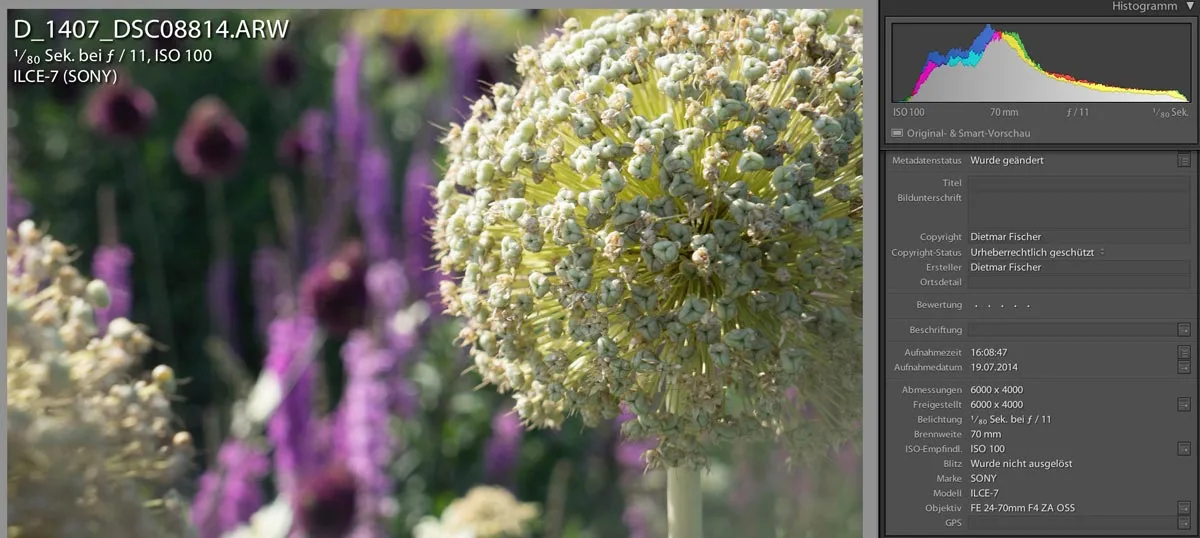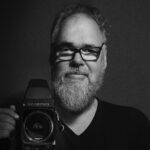Menü


fischeye
Lesedauer:
[rt_reading_time postfix=“Minuten“ postfix_singular=“Minute“]
Geringe Schärfentiefe und ein schönes Bokeh im Hintergrund sind beliebte Stilmittel bei der Komposition von Bildern. Das, was wichtig ist, bleibt scharf, der Rest lenkt nicht mehr vom Hauptmotiv ab, weil er eben unscharf ist.
Um das hinzubekommen, braucht man eine Kamera mit großem Sensor (am besten „Vollformat“) und ein lichtstarkes Objektiv mit langer Brennweite. Auch das ist eine weit verbreitete Meinung.
Stimmt aber nicht!
Das Bild oben ist mit 70mm Brennweite und Blende f/11 aufgenommen und trotzdem ist das Hauptmotiv, die Zwiebelblüte, deutlich vom unscharfen Hintergrund separiert.
Aufgenommen hatte ich das Bild mit einem Zeiss „Vario-Tessar T* FE 24-70mm F4 ZA OSS“ (was ein Name!).
Es hat f/4 als maximale Öffnung und früher dachte ich, das ist viel zu wenig für schöne Freistellungen vom Motiven. Letztendlich war es aber das Objektiv, das ich die meiste Zeit an meiner Sony A7 hatte. Ich mochte es, weil es relativ kompakt war und eine gute Abbildungsleistung hatte.
Auch der Vollformatsensor war mir früher wichtig, weil er auch die Sensorgröße einen Einfluß auf die Schärfentiefe hat. Mir ist heute ein kompaktes System aber viel wichtiger geworden.

Der Trick, der mit eigentlich jedem Standard-Kit-Objektiv funktioniert – und das nicht nur bei Blümchen, sondern auch bei Portraits, ist ganz einfach:
Das war’s auch schon! Auf dem Bild hier war die Blume im Vordergrund vielleicht 50cm vom Objektiv aber locker 2-3m von den lila Blumen im Hintergrund entfernt. Der Hintergrund ist damit auch bei Blende f/11 nicht mehr im Schärfebereich.
Bei den Smartphones ist der Sensor wirklich sehr klein und der Schärfebereich dadurch relativ groß.
Aber ich habe es gerade noch mal mit dem iPhone ausprobiert: Zumindest mit dem Tele-Objektiv läßt sich leicht der Hintergrund unscharf gestalten, auch ohne den Portrait Modus, bei dem ein eigentlich scharfer Hintergrund künstlich unscharf gerechnet wird.
Die Unschärfe, die dabei entsteht, mag ich sogar ganz gerne: Man kann noch erahnen, was den Hintergrund ausmacht, der Blick des Betrachters wird aber trotzdem auf den Vordergrund gelenkt.
Mit einem großen, schweren, und teuren „Bokeh-Monster“, wie einem 85mm f/1.4 Objektiv kann man sehr leicht sehr kleine Bereiche scharf und den Rest unscharf fotografieren.
Wenn man auf so ein Objektiv verzichten will oder muß, kann man ähnliche Bildkompositionen mit nahezu jedem Objektiv und jeder Kamera hinbekommen.
Laßt euch also nicht einreden, dass ihr große Sensoren und lichtstarke, offenblendige Objektive braucht!
Ich persönlich finde es im übrigen viel spannender, wenn man sein Portrait so komponiert, dass der Hintergrund noch als Kontext zum eigentlichen Portrait ein wenig zur Geschichte beiträgt, die das Bild erzählen soll.
Aber Bokeh liebe ich immer noch und habe mir für meine Fuji Kameras das Objektiv geholt, das meiner Meinung nach das schönste und ruhigste Bokeh macht, das ich kenne: Das FUJIFILM XF56mm F1.2 APD, eins der ganz wenigen Objektive mit eingebautem Apodisationsfilter.
Das Bild ist alt, und dieser Artikel eigentlich auch. Ursprünglich habe ich ihn auf elfpunt.net veröffentlicht. Ein Blog über Fotografie und Gadgets, den ich 20 Jahre lang betrieben hatte (2001 -2021). Zuviel Computer- und Technikkram, zu wenig über Fotografie, deshalb hatte ich ihn Anfang des Jahres eingestellt. Aber diesen Artikel wollte ich mit rüber retten. Der Artikel ist auch 2021 einer der am meisten gelesenen Artikel auf elfpunkt.net gewesen und ich finde ihn auch heute noch sehr aktuell.